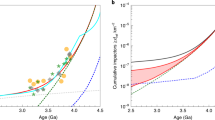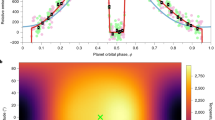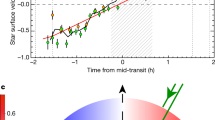Abstract
With the advent of the space shuttle era, increasing rocket activity is expected in the Earth's upper atmosphere. The space shuttle solid-fuelled booster rockets emit ∼150 tonnes of alumina (Al2O3) particles per launch, much of which spreads throughout the upper troposphere and stratosphere1. Such particles can seed aerosols and clouds, and might therefore cause changes in the terrestrial radiation balance and climate2. Estimates are made here showing that average ice nuclei concentrations in the upper troposphere could increase by a factor of 2, and that an aluminium dust layer weighing up to 1,000 tonnes might eventually form in the lower stratosphere.
This is a preview of subscription content, access via your institution
Access options
Subscribe to this journal
Receive 51 print issues and online access
$199.00 per year
only $3.90 per issue
Buy this article
- Purchase on Springer Link
- Instant access to full article PDF
Prices may be subject to local taxes which are calculated during checkout
Similar content being viewed by others
References
Potter, A. E. Proc. Space Shuttle Environmental Assessment Workshop on Stratospheric Effects (NASA TM X-58198, Houston, Texas, 1977).
Pollack, J. B. et al. J. geophys. Res. 81, 1071–1083 (1976).
Brownlee, D. E., Ferry, G. V. & Tomandl, D. Science 191, 1270–1271 (1976).
Hofmann, D. J., Carroll, D. E. & Rosen, J. M. Geophys. Res. Lett. 2, 113–116 (1975).
Pollack, J. B., Toon, O. B., Summers, A., Van Camp, W. & Baldwin, B. J. appl. Met. 15, 247–258 (1976).
Turco, R. P. et al. J. appl. Met. 19, 78–89 (1980).
Hobbs, P. V. Ice Physics (Oxford University Press, 1974).
Parungo, F. P. & Allee, P. A. J. appl. Met. 17, 1856–1863 (1978).
Parungo, F. P. & Allee, P. A. J. appl. Met. 19, 128–130 (1980).
Hindman, E. E., II, & Lala, G. G. J. appl. Met. 19, 122–128 (1980).
Hindman, E. E., Radke, L. F. & Eltgroth, M. W. J. appl. Met. (submitted).
Hindman, E. E. II, Garvey, D. M., Langer, G., Odencrantz, F. K. & Gregory, G. L. J. appl. Met. 19, 175–184 (1980).
Hindman, E. E. & Finnegan, W. G. Pap. 8th Conf. on Inadvertent and Planned Weather Modification, Reno (1981).
Turco, R. P., Hamill, P., Toon, O. B., Whitten, R. C. & Kiang, C. S. J. atmos. Sci. 36, 699–717 (1979); The NASA-Ames Research Center Stratospheric Aerosol Model I. Physical Processes and Computational Analogs (NASA TP 1362, 1979).
Turco, R. P., Toon, O. B., Hamill, P. & Whitten, R. C. J. geophys. Res. 86, 1113–1128 (1981).
Hamill, P., Turco, R. P., Toon, O. B., Kiang, C. S. & Whitten, R. C. J. Aerosol Sci. (in the press).
Pruppacher, H. R. & Klett, J. D. Microphysics of Clouds and Precipitation Ch. 9 (Reidel, Dordrecht, 1978).
Author information
Authors and Affiliations
Rights and permissions
About this article
Cite this article
Turco, R., Toon, O., Whitten, R. et al. Space shuttle ice nuclei. Nature 298, 830–832 (1982). https://doi.org/10.1038/298830a0
Received:
Accepted:
Issue Date:
DOI: https://doi.org/10.1038/298830a0
Comments
By submitting a comment you agree to abide by our Terms and Community Guidelines. If you find something abusive or that does not comply with our terms or guidelines please flag it as inappropriate.



